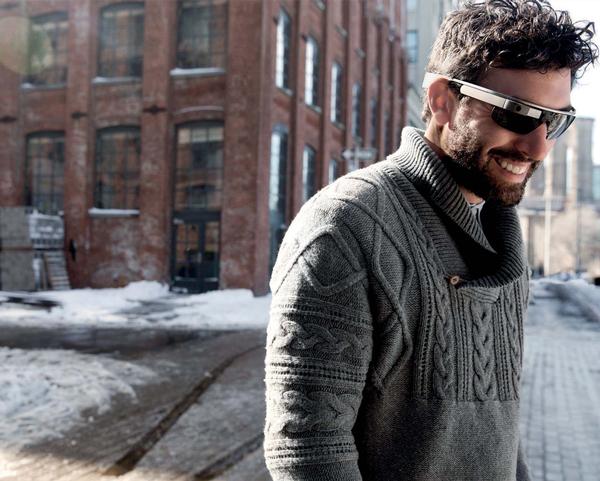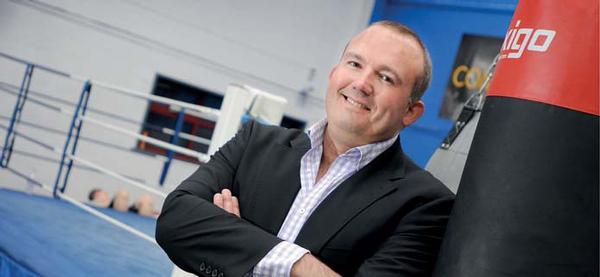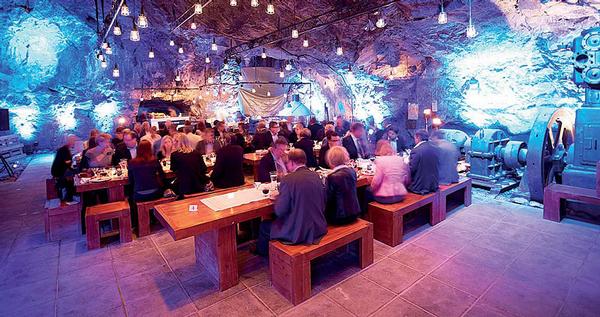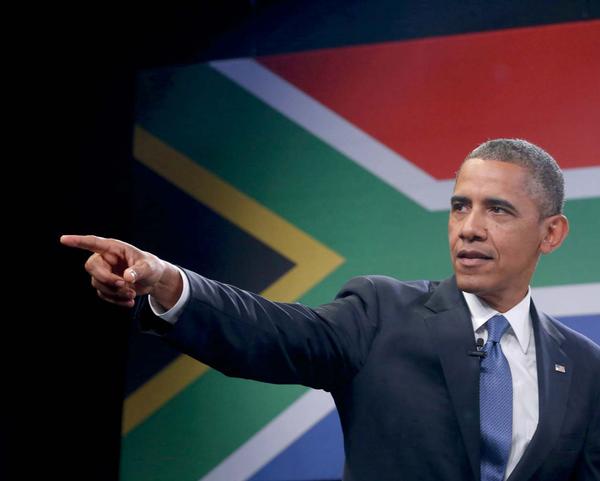
|
 |
Health Club Management Handbook - LEISURE Foresight™ 2014

Trends

|
|
| LEISURE Foresight™ 2014
|

What’s coming down the track for the global leisure industries. Leisure Management examines the trends, technologies and strategies which will shape the future
|
|
|

|
INTERACTIVE TECH

HAVING FUN

Combining technology, entertainment and experiences, South African Breweries used technology to create an imaginative, interactive game for customers – the Extra Cold Mind Reader challenged drinkers to keep thinking cool thoughts, even when presented with images of extreme heat and a range of other distractions.
The more they concentrate on cool thoughts, the more ice cold beer they were rewarded with.
The brain-powered technology was created for Castle Lite – a low-carb, ice-cold beer, and the novel unique sensory experience used interactive lighting, cold air, immersive visuals and sound to complete the experience.
The system was designed by Hellocomputer, and built by Thing- king and used an EEG headset to measure spontaneous brain activity over a short period of time along the scalp. The device also picked up on conscious thought, emotion and facial expressions, all of which it used to control the experience.
|

|
ONLINE REVIEWS

STAR PERFORMANCE

Online reviews are having a huge impact on service businesses and although few operators embraced them to the degree seen in the hotel and restaurant sectors, the opportunity is there to increase business by encouraging and managing reviews across all areas of leisure.
A study by economists at the University of California, Berkeley found a variance of just half a star rating can determine whether a business thrives or goes bust. Researchers focused on restaurant reviews on Yelp.com and found that the difference between 3 and 3.5 stars increased the chance of a business reach- ing capacity at peak times from 13 per cent to as much as 34 per cent.
Further reinforcement of the impact comes from a TripAdvisor study which found that properties with 11 reviews or more on the website see a 28 per cent rise in user engagement when compared to those with 10 or fewer.
Dealing well with complaints relating to online reviews is also important according to a PhoCusWright report which found that 84 per cent of TripAdvisor users said an ap- propriate management response to a bad review improves their impression of a hotel.
| |


|

Online reviews can determine profitability |
|

|
WEARABLE TECH

GOOGLE GLASS

We’re moving from an era when we interface with techonology using keyboard and mouse, to a time where touch and voice are the norm. Wearable technology will find both business - and consumer-facing applications in the leisure industry, with things like Google Glass presenting a number of immediate opportunities.
This technology enables the capturing and sharing of personal video from the users’ eye view, as well as augmented reality functionality, so, for example, trainers will be able to use Google Glass to share coaching tips and techniques with students around the world. We could also see customers being given Google Glass pre-loaded with content to create augmented reality experi- ences. There will be many applica- tions to develop once we get our hands on it in the mass market.
There will also be challenges,as we’ll need protocols to deal with the downside – will we allow customers to wear Google Glass to record and share their experiences for example?
The growth in image-based tech services such as Snapchat, Insta- gram and Instagram Video, Flickr, Vine, and Google Glass are turning photography and video into a communication medium that can re- place words – a valuable resource in an increasingly global economy.
| |


|

What will you do when your customers turn up wearing Google Glass? |
|

|
DEATH

END OF LIFE CARE

There’s an increasing interest in having a ‘good death’ which avoids unnecessary medical intervention. With an ageing pop- ulation, the number of people dying each year is increasing, making it a major growth market.
This gives experts and operators in the spa and hospitality industries an opportunity to develop a new category of specialist, spa-inspired facilities, focused on death. They would give people the chance to reflect and spend time with loved ones, while offering com- fort, personal care, appropriate ritual and a spiritual dimension.
We believe end of life care is a market which is ripe for disruption.
|

|
NEXT GEN CUSTOMERS

NEW BRANDS

When IKEA announced it was working with Marriott to roll out 150 hotels under its recently created Moxy brand, it marked a new departure for both: IKEA is the money behind the roll-out, while Marriott is operating.
Three star Moxy is targeted at Millennials (16 to 34-year-olds), and uses design and technology to deliver elements valued by this age group, while trimming costs with edge of town locations and smaller rooms, made possible by tight design.
We expect to see more unexpected, mould-breaking partnerships opening up opportunities in the market.
See Moxy in Leisure Management issue 4 2013 http://bit.ly/1a5eakV
Jon Wright’s Xercise4Less is building health clubs in Tesco’s redundant food retail space
|

|
NEW PARTNERSHIPS

RETAIL + LEISURE

It’s a bloodbath on the high street in many developed nations, as internet shopping disrupts the entire sector.
This shift is leaving some large retailers with excess floor space which was developed before the boom in online retail and which simply isn’t needed any more. The challenge applies to high street, edge of town and out of town locations.
Retailers are looking for ways to monetise this redundant space and the lei- sure industry is providing some of the most creative solutions from cinemas to gyms.
Health club operator Xercise4Less is one company at the forefront, with the announcement it’s signed a deal with global food retailer Tesco to open 100 health clubs in its stores over the next three years.
The Tesco/Xercise4Less deal hits two sweet spots: firstly, the health club oper- ator will take up unneeded space within Tesco stores and secondly – in a market which is turning into a land-grab – the deal will enable it to roll out clubs quickly and cheaply without the ususal headaches of site-finding and complex, time consuming infrastructure development.
It also gives Xercise4Less a significant captive market of Tesco customers who – it’s predicted – will be able to combine their shopping visit with a workout.
John Wright, MD of Xercise4Less, says the deal is the most significant to have been brokered in the history of the UK health and fitness industry.
We expect further leisure/retail tie ups to emerge, as these sectors work to exploit powerful synergies.
| |


|

Jon Wright’s Xercise4Less is building health clubs in Tesco’s redundant food retail space |
|

|
WELLNESS

CELLULAR HEALTH

We anticipate increasing awareness of the importance of cellular health – something few people have any knowledge of.
Many of the underlying systems which run our bodies at cellular level work through tensions between opposites and the balance between them determines our health.
For example, the health of the gut – which underpins the immune system – relies on the balance between fungi and bacteria. If either dominate, our health is undermined: consume too much sugar or yeast and fungus flourishes, creating an imbalance which leads to candida, athletes foot, thrush and other systemic and localised fungal disorders. This, in turn, has a detrimental effect on other systems, such as the absorbtion of nutrients.
This principle applies in many areas: the cellular pump, which keeps our cells ‘clean’ and our blood pressure healthy, relies on the correct balance between sodium and potassium in the body. Get the balance wrong and the result will be disease and high blood pressure.
A wide range of health factors are reliant on balance – exercise and rest, acid and alkali, oxygen and carbon dioxide – the list is long. The outcome of a good balance is excellent cellular health and a greater likelihood of freedom from disease.
We expect to see a more widespread recognition, within both the allopathic and complementary health fields, of the importance of good cellular health, its role in the fundamental underpinning of wellbeing and of its importance as the ultimate tool in the prevention of disease.
This subtle element of health is unseen and rarely researched, so education to raise awareness will be the first step.
| |


|

Good cellular health is the foundation of wellbeing, but few people are aware of this |
|

|
TRAVEL TRADE

FACILITY INVESTMENT

As online booking and user-generated reviews continue to shake up the travel sector, travel specialists will diversify into other sectors.
After decades of taking a cut from selling holidays which utilise other operators’ facilities, travel businesses are crossing the line and starting to compete with their partners.
TUI is leading the way with its move into facility investment and operation. The company has bought an entire village in Tuscany and is transforming it into a high-end holiday and hotel destination. We expect more to follow. See TUI in Leisure Management issue 2 2013: http://bit.ly/1bQp92W
|

|
POP-UPS

NIMBLE SOLUTIONS

Investing in infrastructure is costly and bricks and mortar tie an operation to a specific location permanently.
We expect the pop up trend which has taken retailing by storm over the last few years to make its way into the leisure industries, opening up opportunities for operators to extend their brand and create novel one-off experiences, as well as trying out locations on a low-cost basis before making a more costly investment.
Pop-ups are innovative and fun, offering creative freedom in their delivery and open- ing up new markets to attract consumers who are drawn to more edgy offerings.
| |


|

?Temporary Finnish restaurant Muru Pops Down ran for 10 days in a former limestone mine |
|

|
WELCOMING GUESTS

NO FRONT DESK

Cloud software enables operators to remove the front desk and instead, welcome guests with a tablet computer and a personal greeting at check-in, rather than being behind a desk.
Hotels and spas are experimenting with tablet check-ins, while some restaurants are trialling app payments which allow customers to avoid a wait for their bill: they can just pay and go once they’ve finished their meal.
|

|
PREDICTING PURCHASING

WEATHER CHANNEL

In the US, the Weather Channel has rebranded as the Weather Co – the Atlanta-based business has more than 75 years’ of weather data and is using it to predict not only the weather, but when people are more likely to buy cer- tain goods. We think big data like this will increasingly be used to help oper- ators understand how their customers behave and how to optimise income.
|

|
CHILDHOOD OBESITY

TEACHING SELF-CARE

The global obesity crisis in children is opening up opportunities for wellness-based businesses to get involved with their education and fitness via individual and family programmes.
We foresee health clubs and spa and wellness operations harnessing their expertise and opening up their facilities to teach obese kids self-care. This would create a whole new market around sup- porting obese children and their families.
Tackling childhood obesity is as much around educating parents as it is about forging good lifestyle habits in their offspring, so programmes could offer support to all family members.
A few specialist operators have under- taken programmes of this nature, but the opportunity has yet to be explored by the private sector and we suggest it could be a lucrative and useful avenue to explore.
|

|
ALL YOU CAN FLY AIRLINES

PAY ONE PRICE

Surf Air, a members-only, fixed-rate aviation service has launched – the first time the pay-one-price model has been applied to an airline.
For US$1,650 a month, members can fly as much as they chose on available west coast US routes and the company plans to expand to other locations.
|

|
WEARABLE TECH

MOBILE BIOMETRICS

Consumers can already monitor aspects of their health – from stress to sleep – via biometric readers and this presents health clubs with an exciting opportunity for constant engagement with customers.
We see a time when health clubs offer apps, combined with internal and external sensors, that firstly monitor and then analyse clients’ health, and give advice based on the findings via wearable tech.
This advice can be given in real-time so people can make better choices, such as how many more calories can be consumed that day, when they need to be more active, or when it’s time to take a break.
This will keep health clubs top of mind with tech-savvy customers, ensuring fitness apps and wearable technology complement rather than replace their membership.
|

|
SEX IN SPAS

NO LONGER TABOO

With some of the world’s most famous, prestigious and well- respected spas beginning to hire out their couples rooms by the hour and the growth of couples treatments outstripping that of single treatments for some, sensual time spent with a partner is becoming good business.
Couples rooms now routinely features large lounging areas or beds, double Jacuzzis and other private facilities, while treatments factor in alone time behind locked doors, champagne and other treats, to create the perfect ambience.
It’s appropriate that spas, with their focus on the holistic, are moving in this direction, as our sexuality is an important part of our wellbeing. We expect this trend to evolve with a focus on developing these options in a wholesome way with sensitivity and integrity.
Sex in spas is consistent with the industry’s spiritual ethos and just as friends are more likely to enjoy andwish to repeat their spa experience as a result of companionable time spent together, so attracting couples brings the benefits of repeat visitation, increased retail spend and opportunities to upsell by adding treatments to basic facility-use charges.
The industry is aware of the importance of retaining a highly professional reputation around this type of offer – especially in parts of the world which have suffered from links with prostitution, so the growth of couples bookings is being played down by the industry – and understandably so, however, we expect this type of offer to become more widespread.
| |


|

Sensual time with a partner is proving to be good for business |
|

|
AFRICA

IN SIGHT OF CHANGE

Back in 2003, Goldman Sachs coined the term BRIC – an acronym for Brazil, Russia, India and China – to group together what it predicted would be the world’s most dominant economies by the year 2025.
Next the CIVETS were identified as being the ones to watch: Columbia, Indonesia, Vietnam, Egypt, Turkey and South Africa – this acronym was coined by Robert Ward at the Economist Intelligence Unit in 2008 to predict the next generation of emerging nations.
Following the development of these economies, we believe the rest of Africa will show exciting growth over the two decades, with the leisure industries already identified as a driver for both the domestic and inbound tourism markets. This will be especially exciting in nations which have developing middle classes and growing tourism infrastructure. We also expect Barack Obama to turn his attentions to Africa following his second term in office.
| |


|

?Barack Obama at the University of Johannesburg, Soweto, South Africa, 29 June 2013 |
|
 |
| Originally published in Leisure Handbook 2014 edition
|
|
 |
|
|
| | | | | | | | | | | | | | |
